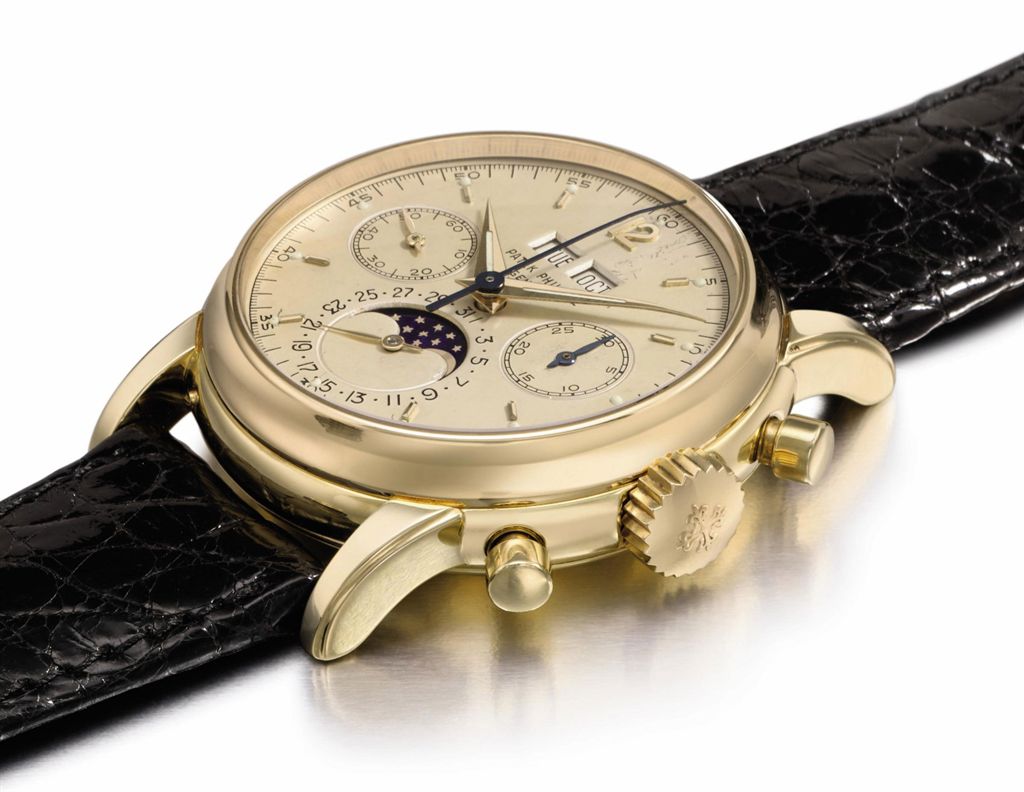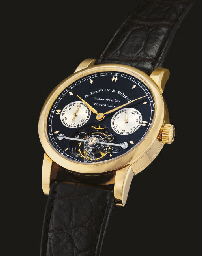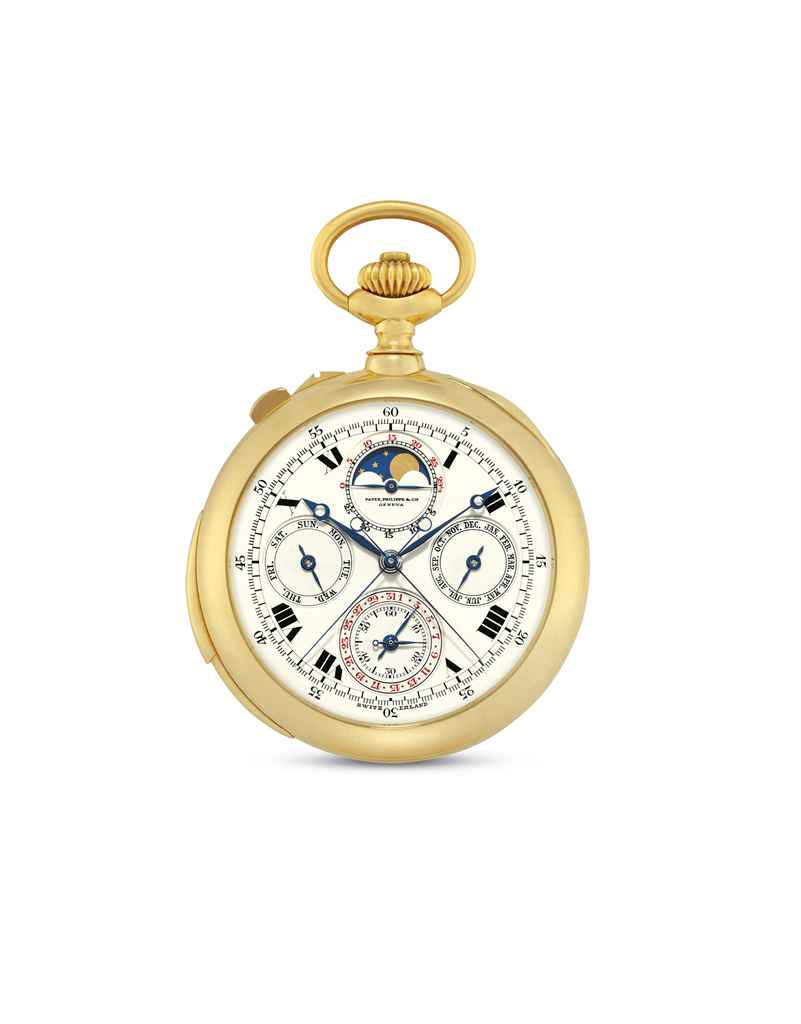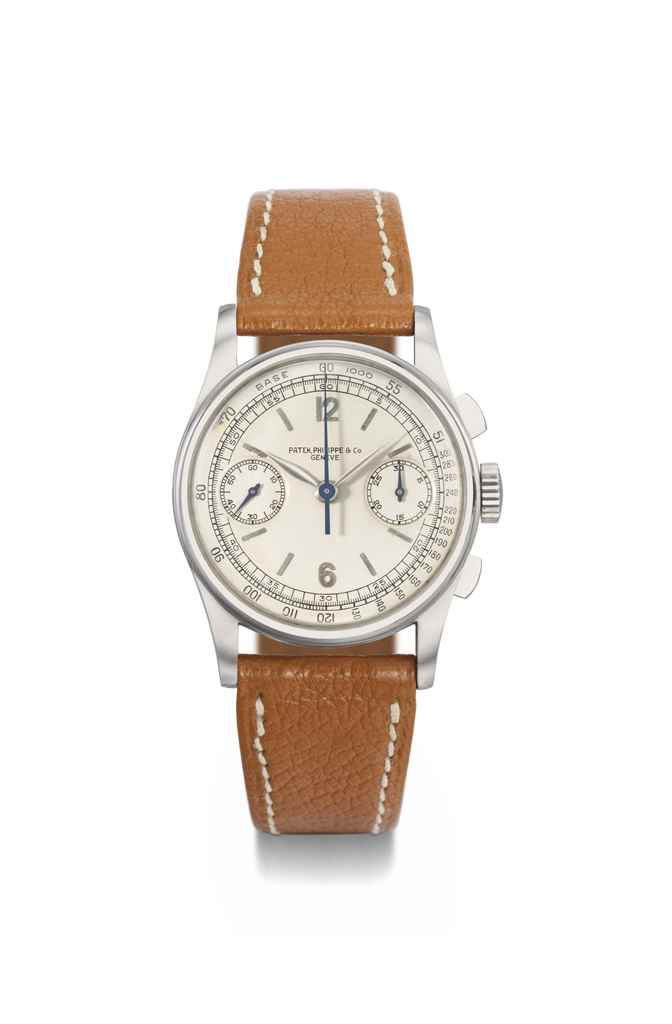A FINE AND RARE PAIR-CASED VERGE FUSEE STRIKING CLOCK-WATCH THOMAS TOMPION LONDON, CIRCA 1697, THE DIAL AND CASES LATER The gilt full plate movement with three tulip and two narrow vase pillars pinned through the backplate, the fusee going train with scroll-pierced stop-iron block and verge escapement regulated by sprung three-arm balance with Tompion type regulation, the locking plate controlled strike train with fine scroll pierced and engraved standing barrel, foliate sculpted steel detent gates and sounding via a hammer positioned beneath the spring barrel on a bell fitted to the interior of the case, the backplate with symmetrical foliate scroll pierced and chased cock decorated with a female mask at the junction with the conforming pierced foot, flanked by silvered regulation disk set within further applied engraved fretwork opposing silvered countwheel with concentric leaf engraved centred and numbered divisions, next to signature Tho: Tompion, London with number 83 engraved just above the concentric ring-turned blued steel strike stop-work wheel partly concealed by the balance cock, now with slightly convex white enamel Roman numeral dial incorporating twin gold collected winding holes to centre and arcaded minute ring with Arabic five minutes above the hour numerals, with fine sculpted gold beetle and poker hands, now in silver-gilt inner case with pierced and engraved scrolling foliate decoration to rear, suspension post and ring at twelve o'clock and fitted with convex glass to bezel, with a leather covered gilt brass outer case with crisp mouldings to bezel surround and waist. The pillar plate 35mm (1.375ins) diameter; the outer case 5.5cm (2.125ins approx.) diameter. Provenance: The property of a private collector, purchased Sotheby's New York sale of The Thielmann Collection of Watches, Clocks and Scientific Instruments 26th June 1989 (lot) 301 for $2,750 USD. Previously in the Wertheimer Collection. Thomas Tompion has often been referred to as the 'father of English clock and watchmaking'. When considering the legacy of his work and influence on subsequent generations, such a compliment is justly deserved. Born in Ickwell, Suffolk in 1639 Thomas Tompion appears to have developed an affinity for metalworking from his father, also named Thomas, who worked as a blacksmith. By 1670 Tompion had moved to London and was working in the clock and watchmaking trade. Although there is no record of his apprenticeship or whether he received any formal training prior to moving to London, he quickly became established and obtained his freedom of the Clockmaker's Company in late 1671. His early clocks demonstrate a close working relationship with the Fromanteel, East and Knibb workshops. Around this time Tompion became friendly with eminent mathematicians and scientists such as Robert Hooke and Jonas Moore - perhaps the most progressive and inventive minds of the day. Such associations lead to Royal commissions, firstly from Charles II for whom Tompion is known to have made one of the earliest balance-spring watches in 1676 and later William III who ordered numerous clocks to furnish his various palaces throughout his reign. As well as being an extremely talented artisan Tompion was also commercially minded, cleverly introducing serial numbering for his watches and clocks from around 1681/2. This, as well as maintaining a high degree of refinement in both the design and construction of his clocks and watches, ensured the highest level of exclusivity for clients purchasing from him. In around 1701 Thomas Tompion took a former apprentice, Edward Banger, into partnership. Banger was originally apprenticed to Thomas Ashby in 1687 but was transferred over to Tompion and gained his freedom of the Clockmaker's Company in 1695. He was clearly a talented maker (when considering the few examples signed by Banger alone) however a serious problem between him and his former master caused the partnership to come to an abrupt end in 1707-8 f
A FINE AND RARE PAIR-CASED VERGE FUSEE STRIKING CLOCK-WATCH THOMAS TOMPION LONDON, CIRCA 1697, THE DIAL AND CASES LATER The gilt full plate movement with three tulip and two narrow vase pillars pinned through the backplate, the fusee going train with scroll-pierced stop-iron block and verge escapement regulated by sprung three-arm balance with Tompion type regulation, the locking plate controlled strike train with fine scroll pierced and engraved standing barrel, foliate sculpted steel detent gates and sounding via a hammer positioned beneath the spring barrel on a bell fitted to the interior of the case, the backplate with symmetrical foliate scroll pierced and chased cock decorated with a female mask at the junction with the conforming pierced foot, flanked by silvered regulation disk set within further applied engraved fretwork opposing silvered countwheel with concentric leaf engraved centred and numbered divisions, next to signature Tho: Tompion, London with number 83 engraved just above the concentric ring-turned blued steel strike stop-work wheel partly concealed by the balance cock, now with slightly convex white enamel Roman numeral dial incorporating twin gold collected winding holes to centre and arcaded minute ring with Arabic five minutes above the hour numerals, with fine sculpted gold beetle and poker hands, now in silver-gilt inner case with pierced and engraved scrolling foliate decoration to rear, suspension post and ring at twelve o'clock and fitted with convex glass to bezel, with a leather covered gilt brass outer case with crisp mouldings to bezel surround and waist. The pillar plate 35mm (1.375ins) diameter; the outer case 5.5cm (2.125ins approx.) diameter. Provenance: The property of a private collector, purchased Sotheby's New York sale of The Thielmann Collection of Watches, Clocks and Scientific Instruments 26th June 1989 (lot) 301 for $2,750 USD. Previously in the Wertheimer Collection. Thomas Tompion has often been referred to as the 'father of English clock and watchmaking'. When considering the legacy of his work and influence on subsequent generations, such a compliment is justly deserved. Born in Ickwell, Suffolk in 1639 Thomas Tompion appears to have developed an affinity for metalworking from his father, also named Thomas, who worked as a blacksmith. By 1670 Tompion had moved to London and was working in the clock and watchmaking trade. Although there is no record of his apprenticeship or whether he received any formal training prior to moving to London, he quickly became established and obtained his freedom of the Clockmaker's Company in late 1671. His early clocks demonstrate a close working relationship with the Fromanteel, East and Knibb workshops. Around this time Tompion became friendly with eminent mathematicians and scientists such as Robert Hooke and Jonas Moore - perhaps the most progressive and inventive minds of the day. Such associations lead to Royal commissions, firstly from Charles II for whom Tompion is known to have made one of the earliest balance-spring watches in 1676 and later William III who ordered numerous clocks to furnish his various palaces throughout his reign. As well as being an extremely talented artisan Tompion was also commercially minded, cleverly introducing serial numbering for his watches and clocks from around 1681/2. This, as well as maintaining a high degree of refinement in both the design and construction of his clocks and watches, ensured the highest level of exclusivity for clients purchasing from him. In around 1701 Thomas Tompion took a former apprentice, Edward Banger, into partnership. Banger was originally apprenticed to Thomas Ashby in 1687 but was transferred over to Tompion and gained his freedom of the Clockmaker's Company in 1695. He was clearly a talented maker (when considering the few examples signed by Banger alone) however a serious problem between him and his former master caused the partnership to come to an abrupt end in 1707-8 f















Testen Sie LotSearch und seine Premium-Features 7 Tage - ohne Kosten!
Lassen Sie sich automatisch über neue Objekte in kommenden Auktionen benachrichtigen.
Suchauftrag anlegen